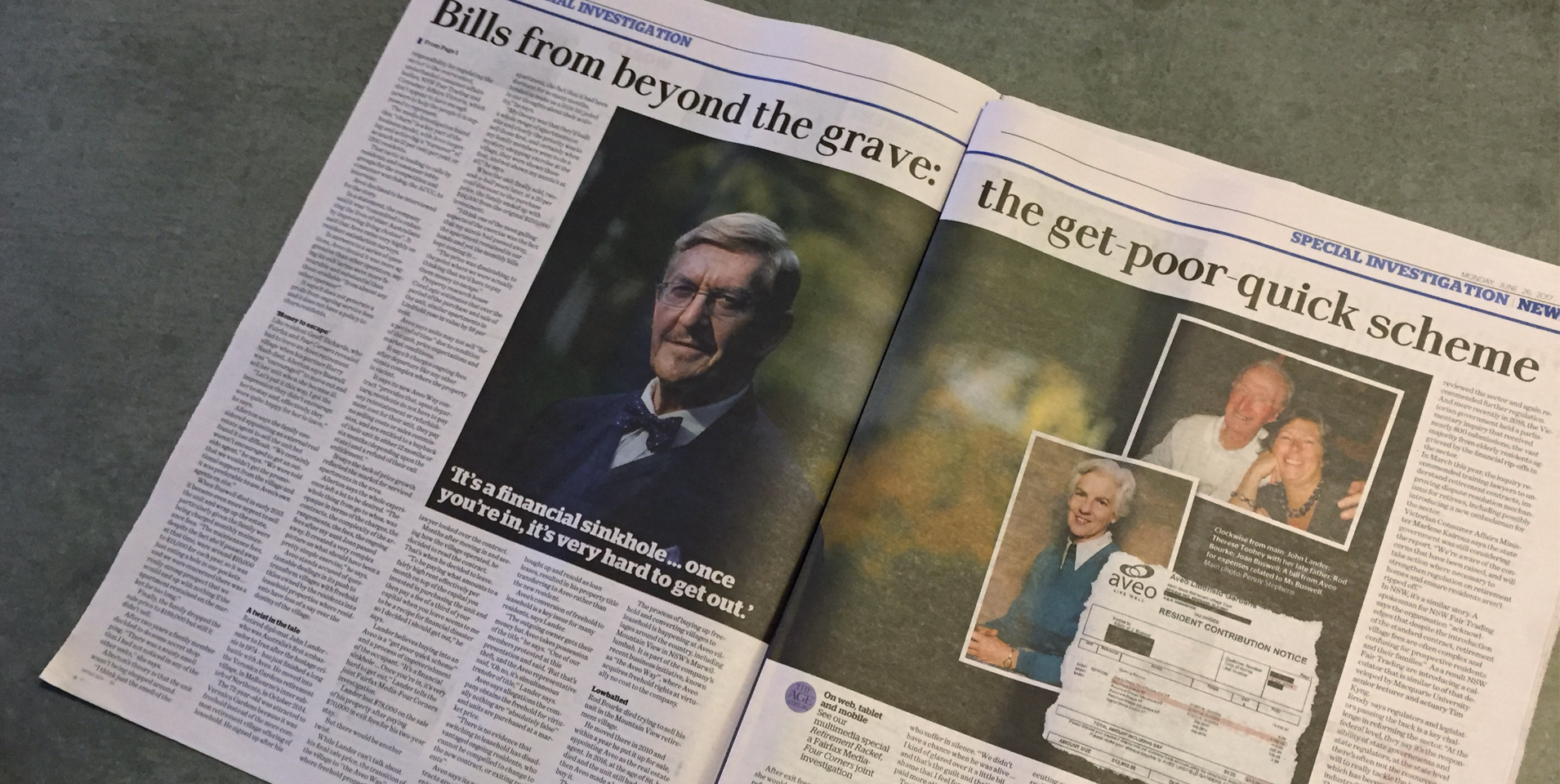
Before you read this article, you should know that we support the development of retirement living housing and communities because we have the insights, gained through years of research, to demonstrate that it is attractive to older Australians. We are agnostic on the model but very clear on the demand.
When Adele Ferguson comes knocking you better think carefully about answering. But answer that door you must, if you want a voice in reporting.
In street parlance, over the past few weeks Aveo has been monstered by Ferguson and her collaborators at 4 Corners and Fairfax. The published stories are stomach churning and heart rending. One cannot feel anything but indignance at the injustice.
We owe a credit to the media to call out injustice in any form. But it is challenging to see the narrowing of media focus on just a few topics each day, each week. With revenue and profits in freefall because we stopped buying papers, it reflects basic ROI: the more content you produce on a single subject, the less you need spend on other investigations.
So that means, when experienced journalists like Adele Ferguson and her colleagues are in formation, you know the attack is going to be long and painful. Also, to be fair, it can often be somewhat justified (7 Eleven, Dominos, etc.).
In the case of Aveo we are led to believe that the industry is rotten, not just Aveo. The informed media consumer knows that life is never that simple.
First of all, Aveo does not push every resident to the brink of collapse. If you have 10 minutes, Aveo’s response to Fairfax/4 Corners and the ASX makes for interesting reading, albeit not that exciting. The stories are much more compelling.
Secondly, as the reporting suggests, there are many thousands of Australians living in retirement communities and proportionately few are fighting the operators or ringing the press.
There is no doubt the industry needs to reform. Victoria had its parliamentary inquiry (recommendations here) and the industry has been slow in its response.
Cast your eye across the internet and you’ll quickly see that deferred management fees (DFMs) have been the subject of consumer, advocate and political ire for many years. From their communications, operators are clearly conscious of the concern.
We must also remember that these structures were set up for a time when retirement living was for people entering retirement, not well into it.
From a government perspective, it is the consumer/taxpayer that comes first. Policy makers look to disruptors to meet consumer needs with different models that avoid over-regulation but don’t break the law. However – like Uber and taxis, and AirBnB and hotels – government must eventually front with a transition policy and approach. Markets wait to be pushed.
You can read articles about older people and housing from our experienced retirement living PR and digital expert, Caroline Warne.
Interestingly, retirement villages have similarities to digital collaboration platforms. The operator provides the platform (village) and the users (residents) pay to access the experience. Both the company and the resident make significant investments.
Our research demonstrates that people buy into retirement villages for the quality of accommodation and facilities (based on their perceptions and financial capacity) and the experience which can be defined as a mix of safety, social connections, pride of place and access to services (increasingly in-home care).
The alternative to retirement living is downsizing to a quiet cul-de-sac in the suburbs, a country town or an inner-city apartment. Many people don’t like the loneliness and lack of like-minded community these can present – particularly a brown and beige, hard edged, minimal apartment 10 floors above a traffic snarl.
So, there is a demand. And there a diverse range of operators working hard to deliver on resident expectations – with a few expectations of their own about the relationship they have with residents. This is, after all, a trade of property and services.
Our health & ageing and property teams are working right now on new not-for-profit retirement living developments, major operator networks and interesting new models with our clients. Through our network, we are also aware of where the advocates stand on the issue and the likely changes to come.
Here are a few actions village operators can take to design and communicate better outcomes for villages:
- Social research with communities of older people local to developments to channel insights into building design and experiences, meeting market needs, and building an engaged network of interested buyers or referrers.
- Co-design ‘place’ with place identity models and methods to create a sense of village pride that can be shared by operators and residents over time. Place models lead to innovative asset (physical features), experience and culture development.
- Co-design lifestyle experiences and facilities using contemporary design thinking/customer experience (CX) methods that engage residents creatively, and build neighbourhood advocacy for when property turns over. Co-design establishes what matters most to people while demonstrating the investment required to achieve their aspirations.
- Shared value framing to establish the social needs and economic outcomes both the residents and operator seek. By establishing shared purpose and shared value creation goals, the relationship between residents and operators changes – and with it the conversations.
- Social impact measurement, in collaboration with residents, to define and report on the improvements in people’s lives that retirement living can create (and find ways to create more impact).

